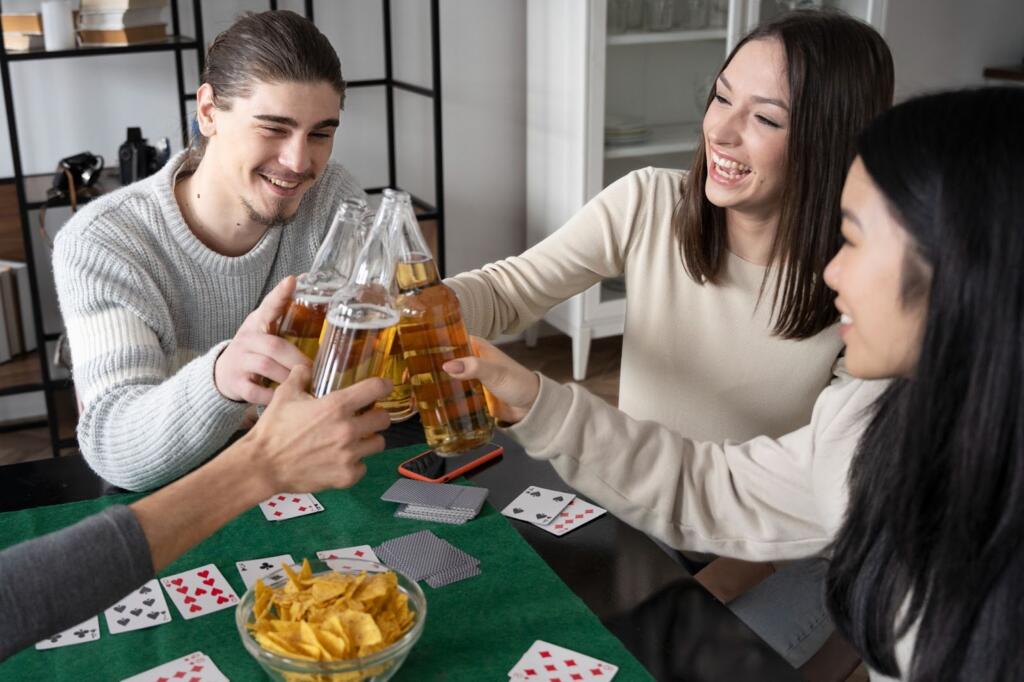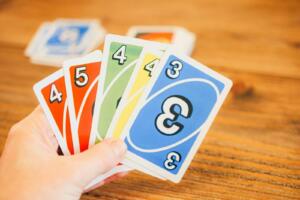Table of Contents

Drinking card games have roots stretching back to medieval Europe and Qing Dynasty China, where communal drinking and card-playing were intertwined social rituals. In 15th-century France, for example, nobles would gather for “obligatory” card games during feast days, often incorporating drinking as part of the entertainment. As with many cultural rituals surrounding alcohol, rules vary by geography, personal opinion, and other highly subjective factors, often adapting to the preferences and traditions of each group playing.
Introduction to Card Games
Card games, whose origins trace back to 9th-century China before spreading globally via trade routes, have evolved into a multitude of formats. Traditional games like Poker emerged in 19th-century America, blending elements from European gambling cards and indigenous games, while Solitaire gained popularity in the early 20th century as a form of solitary entertainment. Modern games like Uno, invented in 1971, reflect a shift toward family-friendly, quick gameplay, illustrating the continual adaptation of card games to fit changing social contexts.
Best Drinking Card Games
Classics like Kings require a deck of cards, a cup, and beer. Other games like Asshole (or President) add a strategic element where players race to get rid of cards and rank them from lowest to highest, while Screw Your Neighbor asks players to get the lowest card value while swapping cards around the table. Similar to Kings, Kings cup involves players drawing cards and performing actions related to the card drawn.
Other games like Beeramid add a visual twist, as players are asked to build a pyramid with cards and assign drinks based on matches with the flipped cards. Killer introduces deception; players try to identify a ‘killer’ based on winks while avoiding penalties for being wrong.
Types of Card Game
Drinking card games can be grouped into several main types based on how they are played. Trick-taking games rely on players each playing a card per round, competing to win “tricks”. Shedding games require players to discard all their cards first, with Uno and President being well-known examples. Matching or melding games, like Rummy and Canasta, focus on collecting specific sets or combinations of cards. Card exchange games involve swapping cards with others or from a common pool, aiming to improve one’s hand
How to Play Card Games
The steps for playing a card game vary widely and are shaped by the specific game’s rules. Most begin with shuffling and dealing cards, but from there the rules vary widely. In trick-taking games like Bridge—dating back to early 20th-century England—, players compete to win tricks by playing higher cards and usually must follow suit. Shedding games, such as Uno or the Japanese Daifugō, focus on being the first to discard all cards, often using special action cards to change gameplay.
Matching games like Rummy involve collecting sets or sequences of cards, while exchange games center on swapping cards to improve hands. In hand comparison games like Poker, players bet and compare card values to determine the winner. Because rules differ greatly, it’s important to clarify them before starting.
Safety Precautions
When enjoying card games, especially those involving drinking, safety should always be a priority. Research published by the National Institute on Alcohol Abuse and Alcoholism emphasizes pacing alcohol consumption to reduce risks associated with binge drinking. Make sure everyone playing understands the rules clearly to avoid confusion or frustration that could spoil the fun. If players need to step away, have a plan for safe transportation to prevent impaired driving and always maintain a respectful and inclusive atmosphere.
Tips for Hosting a Party
Start by planning ahead and deciding on a clear theme or activity to keep guests engaged, such as an outdoor picnic or beach gathering. Research from hospitality studies suggests that thematic gatherings—such as 1920s speakeasy nights or vintage casino-style events—can increase participation and create immersive experiences. Offering a variety of food and drinks that cater to different tastes and dietary preferences helps ensure everyone feels included. Creating a playlist that matches the mood can keep the energy positive throughout the event. It’s also a good idea to have games or activities ready, like card games or group challenges
Card Games for Socialising
Drinking card games have long played a role in social bonding, with origins reaching back to early card-playing traditions in Europe. A 2018 survey published by the National Endowment for the Arts found that over 30% of American adults engage in card games as part of their leisure, often citing the games’ ability to facilitate conversation and reduce social anxiety.
Conclusion
Drinking card games have stood the test of time, with millions of players worldwide using them to add fun and connection to social settings. In fact, a 2015 study published in Frontiers in Psychology explains how joint attention—simply focusing on the same object or task with another person—can increase feelings of social closeness. Classic games like Kings or President have maintained popularity for decades, while newer favorites like Uno have sold over 500 million copies globally. Whether used as an icebreaker, a source of friendly competition, or simply a way to make memories, card games continue to unite people across generations.
FAQs
What are the best drinking card games for parties?
The best drinking card games for parties include Kings (King’s Cup), Pyramid, and Asshole (President), all known for easy rules and lively fun. Other popular choices are Ride the Bus, Higher or Lower, and Snap for Shots, all easy to learn and guaranteed to keep the atmosphere fun and spirited
How do I play Kings Cup?
To play Kings Cup, place an empty cup in the center of the table and spread a deck of cards face down around it. Players take turns drawing cards and must follow the specific rule assigned to each card—for example, drawing a 2 means choosing someone to drink, while an Ace triggers a “waterfall” where everyone drinks in sequence. When the first three Kings are drawn, the players add some of their drink to the central cup, and the person who draws the fourth King must drink the entire contents of that cup, ending the game
What are the rules for President?
President is a shedding game where players race to get rid of all their cards, with the first to do so becoming the President for the next round. Players must play cards equal to or higher than the previous play, matching the number of cards laid down. The lowest-ranked player, often called the Asshole, deals the cards and must give their highest cards to the President, who in return gives back their worst cards.



